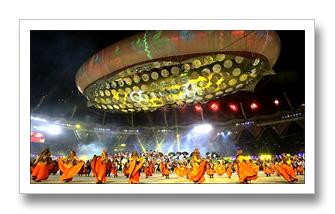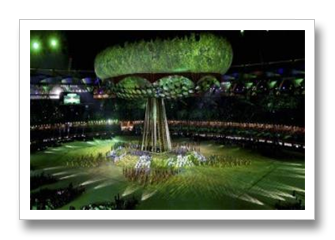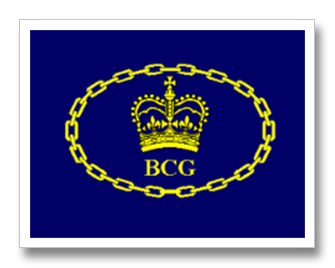Source: The Times of India:
India today put behind a nightmarish build-up of scandals, filth and dirt and missed deadlines to come up with a dazzling and vibrant opening ceremony for the Commonwealth Games -- the country's biggest sporting spectacle -- watched live by a global audience of around three billion.
Against the backdrop of an early October sun set, the spanking new Jawahar Lal Nehru Stadium turned into a golden hue as the Rs 44 crore aerostat lifted into the skies and a bevy of puppets danced and over 800 drummers heralded the event.
A spectacular laser fireworks show lit up the evening sky and India took a giant leap, 28 years after it hosted the Asian Games.
In a neat diplomatic compromise, Prince Charles, representing Queen Elizabeth, the head of the Commonwealth, and President Pratibha Patil did the honours at the inaugural ceremony, amid thunderous cheers from the capacity 60,000 crowd.
"I have much pleasure in declaring the 19th Commonwealth Games open", the Prince said reading out a message from the British monarch.
This was followed by the address of President Patil, who concluded by saying " the 2010 Commonwealth Games in Delhi are now open. Let the Games begin", signalling the formal commencement of the sporting extravaganza.
Prime Minister Manmohan Singh, his cabinet colleagues, former President APJ Abdul Kalam, Congress President Sonia Gandhi, General Secretary Rahul Gandhi, Delhi Chief Minister Sheila Dikshit, Maldives President Mohammed Nashid, Prince of Monaco Albert II, Commonwealth Games Federation President Mike Fennell, Organising Committee Chairman Suresh Kalmadi and a host of dignitaries were present at the ceremony.
It was a mix of both cheers and jeers for Kalmadi when he made his speech while references to Dikshit were received by loud cheers in the audience.
After brief speeches by Commonwealth Games Federation chief Mike Fennell and Organising Committee Chairman Suresh Kalmadi, the Queen's Baton, which traversed through all the 71 Commonwealth nations made a grand entry with Bindra being given the honour.
Badminton star Saina Nehwal, Beijing Olympic Games bronze medallist boxer Vijender Singh and wrestler Sushil Kumar were the others who carried the baton.
It was followed by the arrival of the Games flags of all the participating countries and the oath-taking ceremony by the Indian captain Bindra.
There was also a section dedicated to the great tradition of learning which unfolded under the Knowledge Tree - a sacred space of Learning - presenting the Indian Classical dance and music that have been passed on through the Guru shishya Parampara.
The production comprised six classical dances of India, including Odissi from Orissa, Bharatnatyam from Tamil Nadu, Kathak from North India, Manipuri from Manipur, Mohiniattam from Kerala and Kuchipudi from Andhra Pradesh.
Each classical dance represented a season -- Odissi (Spring), Bharatnatyam (Summer), Kathak (Monsoon), Manipuri (Autumn), Mohiniattam (Fall), Kuchipudi (Winter).
Through dance, music and projections on the aerostat of tree leaves, the production captured the emotions as experienced through changing seasons.
India's Yogic way of life was also on display with a presentation of the practice of YOGA - the ultimate union of the body, mind and soul.
All along the ceremony, the moving lights on the helium balloon continued to change their hues, projecting life size revolving images of the action on the ground.
The past few weeks of negative publicity that had dogged the nearly Rs 70,000 crore mega-event was quickly forgotten as the glittering opening ceremony, which encapsulated a fascinating mix of culture and modernity, kept the spectators enthralled for more than two hours.
The ceremony, which set the stage for 12 days of intense competition will see over 7000 athletes from 71 countries vying for honours.
The aerostat, a giant helium balloon was dramatically lifted to its full height amid the sounds of Nagada drums.
A spectacular display of drummers from various parts of India then took centrestage and Keshav, a child prodigy from Auroville, Puducherry, was the cynosure of all eyes.
1050 school children performed a choreography of the Namaste sign, which presented the 23 officially recognised languages of India through projections on the aerostat.
The athletes parade began in which 71 women, dressed in sarees that not only represents different designs form the various Indian corners but also myriad patterns, colours and styles, carried their country's placards.
The 619-member strong Indian contingent, which had Olympic gold medallist shooter Abhinav Bindra as the flag-bearer, drew the loudest cheers as it walked into the jam-packed stadium in the presence of a host of dignitaries, International Olympic Committee and CGF officials.
The Pakistani contingent drew a heavy round of applause from the crowd, notwithstanding the irritants in the bilateral ties.
816 performers together performed a choreography that formed the shape of a sun doing the Suryanmaskar - a series of Yoga postures done in salutation to the sun. Performers on the center stage also displayed some of the most complicated asanas.
The performers then dramatically changed the choreography and began to spiral, representing the kundalini - the coiled energy, an instinctive force that lies at the base of the spine.
Then there was the Great Indian Journey, where a train made a grand arrival as the Cheraw dancers from Mizoram did the Bamboo dance to give the Rhythm for the train.
There was also a segment on Mahatma Gandhi, where the Father of nation was paid rich tribute through a simplistic, humanistic form, depicted through sand animation based on the historic moment of the Dandi March with Mahatma's favourite hymn - Vaishnavo Janato played at the background.
Folk dancers from various corners of the country also came together to rejoice and dance in celebration of the message of the Mahatma, showcasing the ultimate richness in India's folk culture.
The opening ceremony finally culminated with the rendition of Oscar winning music composer AR Rahman's CWG 2010 Anthem -- Jeeyo, Utho, Badho, Jeeto (Live, Rise, Move, Win) -- to inspire all the athletes to give them the push to victory.
In his address Kalmadi, widely criticised for the controversies that surrounded the delayed preparations to the Games, said "India is ready to host a great Commonwealth Games."
"Despite the bad publicity, all the Commonwealth nations stood by India as Delhi becomes the largest ever in the history of the Commonwealth Games," he said.
"We are prepared to deliver a great Games," he concluded. In his brief address, Prime Minister Manmohan Singh said, "Welcome to India. Welcome to the Games. Millions are waiting eagerly to watch the Games unfold".
The formalities, with the march past forming the major chunk, were followed by a 40-minute cultural display in which classical Indian dances, a fine yoga display and a Bollywood-style show.
The Indian railway train was pulled by the age-old steam engine to the strains of the Rahman-hit 'Chayya Chayya' from the film 'Dil Se'.
A giant figure of Lord Buddha was created and rose up from the centre stage to rise up to the canopy.
Instrumental rendering of Mahatma Gandhi's favourite song 'Vaishnavo Janato' was done with a figure of the Father of the nation also created through technology in the middle of the stage.
The stadium reverberated with Rahman's Games theme song "Yaaro, India Bula Liya" and his famous "Jai Ho" number from his Oscar-winning " Slumdog Millionaire" album, in the midst of a spectacular fireworks display, before the curtains came down on the spectacular ceremony.
For the first time in Games history the athletes who took part in the march past were later seated on the periphery to watch the remaining part of the pageant.
A tight security blanket was thrown around the capital with snipers too placed on building terraces situated on the periphery of the stadium's approach roads ahead of the commencement.
The 19th edition of the Games will see more than 6,800 athletes and officials, the biggest-ever assembly in the history of the multi-discipline event which began in 1930, taking part in 17 disciplines ranging from athletics to netball and lawn bowls.
Competitions in 17 disciplines would commence in earnest tomorrow with the opening day seeing eight gold medals being decided.
theFundooGeek recommended reading :
- XIX CommonWealth Games
- CommonWealth Games Federation
- 2010 Commonwealth Games - Wikipedia
- Biggest ever Commonwealth Games begins in Delhi
- Standing Ovation for India
- CWG gets off to breathtaking start
- Live Updates of XIX CWG 2010, Delhi












 Newer Post
Newer Post
 Home
Home






Comments :
0 comments to “The Biggest ever Commonwealth Games Begin in Delhi, India”
Post a Comment